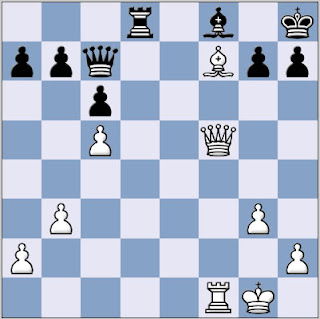In the first against Dr Max Euwe in Amsterdam in 1920:

Réti played 1 ... Bh3! either winning the White queen or forcing mate. The game continued:
2 Qxa8 Bc5+; 3 Kh1 Bxg2+; 4 Kxg2 Qg4+; 5 Kf1 Qf3+; 6 Ke1 Qf2 mate
Our second position was the conclusion to Réti's brilliancy prize winning miniature against Efim Bogojuboff at New York 1924:

Réti played 1 Be8 and Black resigned.
There is no satisfactory defence against the threat of 2 Qxf8, Even 1 ... h6 leads to immediate mate: 2 Qxf8+ Kh7; 3 Bg6+! Kxg6; 4 Qf5 mate
There were few correct solutions to the puzzles, although Brian Wood did suggest 1 ... Bf5 in the first position, which also leads to a very big advantage for Black.
The game against Bogojuboff is regarded as one of the greatest ever played, here it is in full with notes by Alekhine from the tournament book:
Richard Réti - Efim Bogoljubov, New York 1924
1.Nf3 d5 2.c4 e6
As for the merit of this system of defence, compare the game Reti vs. Yates in the
sixth round.
3.g3 Nf6 4.Bg2 Bd6 5.O-O O-O 6.b3 Re8 7.Bb2 Nbd7 8.d4
To our way of thinking, this is the clear positional refutation of 2...e6, which, by the way, was first played by Capablanca (as Black) against Marshall and is based upon the simple circumstance that Black cannot find a method for the effective development of his Queen's Bishop.
8 ... c6 9.Nbd2
In the game referred to, Capablanca, in a wholly analogous position, played ...Ne4 and likewise obtained an advantage thereby. Of course, Reti's quieter development is also quite good.
9 ... Ne4
If the liberating move of 9...e5, recommended by Rubinstein and others, is really the best here then it furnishes the most striking proof that Black's entire arrangement of his game was faulty. For the simple continuation 10.cxd5 cxd5 11.dxe5 Nxe5 12.Nxe5 Bxe5 13.Bxe5 Rxe5 14.Nc4 Re8 15.Ne3 Be6 16.Qd4, would have given White a direct attack against the isolated Queen's pawn, without permitting the opponent any chances whatsoever. Moreover, the move selected by Bogoljubow leads eventually to a double exchange of Knights, without moving the principal disadvantage of his position.
10.Nxe4 dxe4 11.Ne5 f5
Obviously forced.
12.f3
The proper strategy. After Black has weakened his position in the center, White forthwith must aim to change the closed game into an open one in order to make as much as possible out of that weakness.
12. ... exf3 13.Bxf3
Not 13.exf3, because the e pawn must be utilized as a battering ram.
13. ... Qc7
Also after 13...Nxe5 14.dxe5 Bc5+ 15.Kg2 Bd7 (after the exchange of Queens, this Bishop could not get out at all) 16.e4, White would have retained a decisive advantage in position.
14.Nxd7 Bxd7 15.e4 e5
Otherwise would follow 16.e5, to be followed by a break by means of d5 or g4. After the text move, however, Black appears to have surmounted the greater part of his early difficulty and it calls for exeptionally fine play on the part of White in order to make the hidden advantages of his position count so rapidly and convincingly.
16.c5 Bf8 17.Qc2
Attacking simultaneously both of Black's center pawns.
17. ... exd4
Black's sphere of action is circumscribed; for instance, 17...fxe4 clearly would not do on account of the two-fold threat against h7 and e5, after 18.Bxe4
18.exf5 Rad8
After 18...Re5 19.Qc4+ Kh8 20.f6, among other lines, would be very strong.
19.Bh5
The initial move in an exactly calculated, decisive manouver, the end of which will worthily crown White's model play.
19. ... Re5 20.Bxd4 Rxf5
If 20...Rd5 21.Qc4 Kh8 22.Bg4, with a pawn plus and a superior position.
21.Rxf5 Bxf5 22.Qxf5 Rxd4 23.Rf1 Rd8
Or 23...Qe7 24.Bf7+ Kh8 25.Bd5 Qf6 26.Qc8, etc. Black is left without any
defence.
24.Bf7+ Kh8 25.Be8
A sparkling conclusion! Black resigned, for, after 25...Bxc5+, he loses at least the Bishop.
Rightfully, this game was awarded the first brilliancy
prize. 1-0

No comments:
Post a Comment